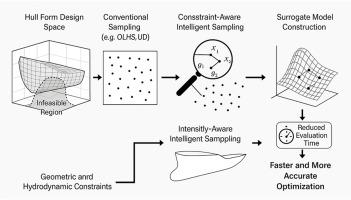Enhancing surrogate model accuracy in ship design optimization through intelligent constraint-aware sample selection
IF 8
2区 计算机科学
Q1 AUTOMATION & CONTROL SYSTEMS
Engineering Applications of Artificial Intelligence
Pub Date : 2025-10-22
DOI:10.1016/j.engappai.2025.112716
引用次数: 0
Abstract
For the hull form optimization design problem based on numerical simulation, constructing a surrogate model is usually required to reduce computational cost and time. However, since the existing sample point selection methods do not consider the influence of constraint conditions on the sampling space, the effectiveness of their sample point selection is not high, which is also one of the main reasons for the high cost of constructing a high-precision surrogate model. Therefore, this paper proposes an improved sampling method to achieve effective selection of sample points in the feasible region and improve the efficiency of the surrogate model development. The proposed method uses data mining to identify the potential mapping relationship between optimization variables and constraint conditions, realizes the selection of sample points in the space satisfying constraints, and then constructs an surrogate model in the feasible region to achieve efficient hull form optimization. Applying this method to the actual hull form optimization process of a 7500 Deadweight Tonnage (DWT) bulk carrier shows that under the same sample size, the prediction accuracy of the surrogate model is significantly improved, and the optimization result similar to that of the traditional method is obtained, verifying the engineering applicability of the intelligent sampling process proposed in this paper. This paper proposes an intelligent sampling framework integrating data mining, innovatively embeds data mining technology into the sampling process, realizes the reduction of sampling space and optimization space from the full space to the constraint subspace, leading to ship intelligent optimization.

通过智能约束感知样本选择提高船舶设计优化中代理模型的精度
对于基于数值模拟的船体形状优化设计问题,通常需要构建代理模型以减少计算成本和时间。然而,由于现有的样本点选择方法没有考虑约束条件对采样空间的影响,其样本点选择的有效性不高,这也是构建高精度代理模型成本高的主要原因之一。因此,本文提出了一种改进的采样方法,以实现可行区域内样本点的有效选择,提高代理模型开发的效率。该方法利用数据挖掘方法识别优化变量与约束条件之间的潜在映射关系,在满足约束条件的空间中实现样本点的选择,然后在可行区域构建代理模型,实现高效的船体形状优化。将该方法应用于某7500载重吨位(DWT)散货船的实际船体形状优化过程中,结果表明,在相同样本量下,代理模型的预测精度显著提高,获得与传统方法相似的优化结果,验证了本文提出的智能抽样过程的工程适用性。本文提出了一种集成数据挖掘的智能采样框架,创新性地将数据挖掘技术嵌入到采样过程中,实现了从全空间到约束子空间的采样空间和优化空间的缩减,实现了船舶智能优化。
本文章由计算机程序翻译,如有差异,请以英文原文为准。
求助全文
约1分钟内获得全文
求助全文
来源期刊

Engineering Applications of Artificial Intelligence
工程技术-工程:电子与电气
CiteScore
9.60
自引率
10.00%
发文量
505
审稿时长
68 days
期刊介绍:
Artificial Intelligence (AI) is pivotal in driving the fourth industrial revolution, witnessing remarkable advancements across various machine learning methodologies. AI techniques have become indispensable tools for practicing engineers, enabling them to tackle previously insurmountable challenges. Engineering Applications of Artificial Intelligence serves as a global platform for the swift dissemination of research elucidating the practical application of AI methods across all engineering disciplines. Submitted papers are expected to present novel aspects of AI utilized in real-world engineering applications, validated using publicly available datasets to ensure the replicability of research outcomes. Join us in exploring the transformative potential of AI in engineering.
 求助内容:
求助内容: 应助结果提醒方式:
应助结果提醒方式:


